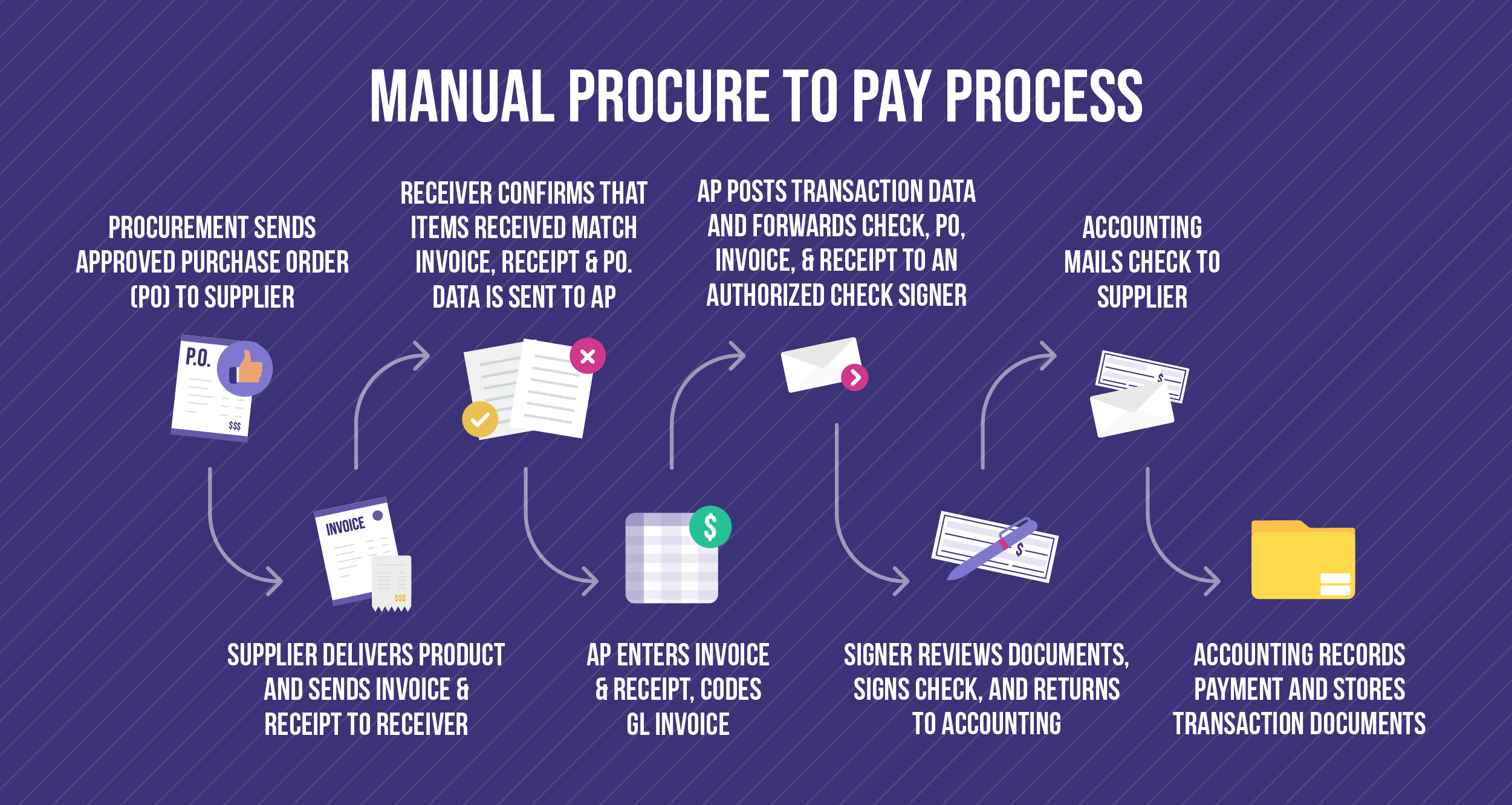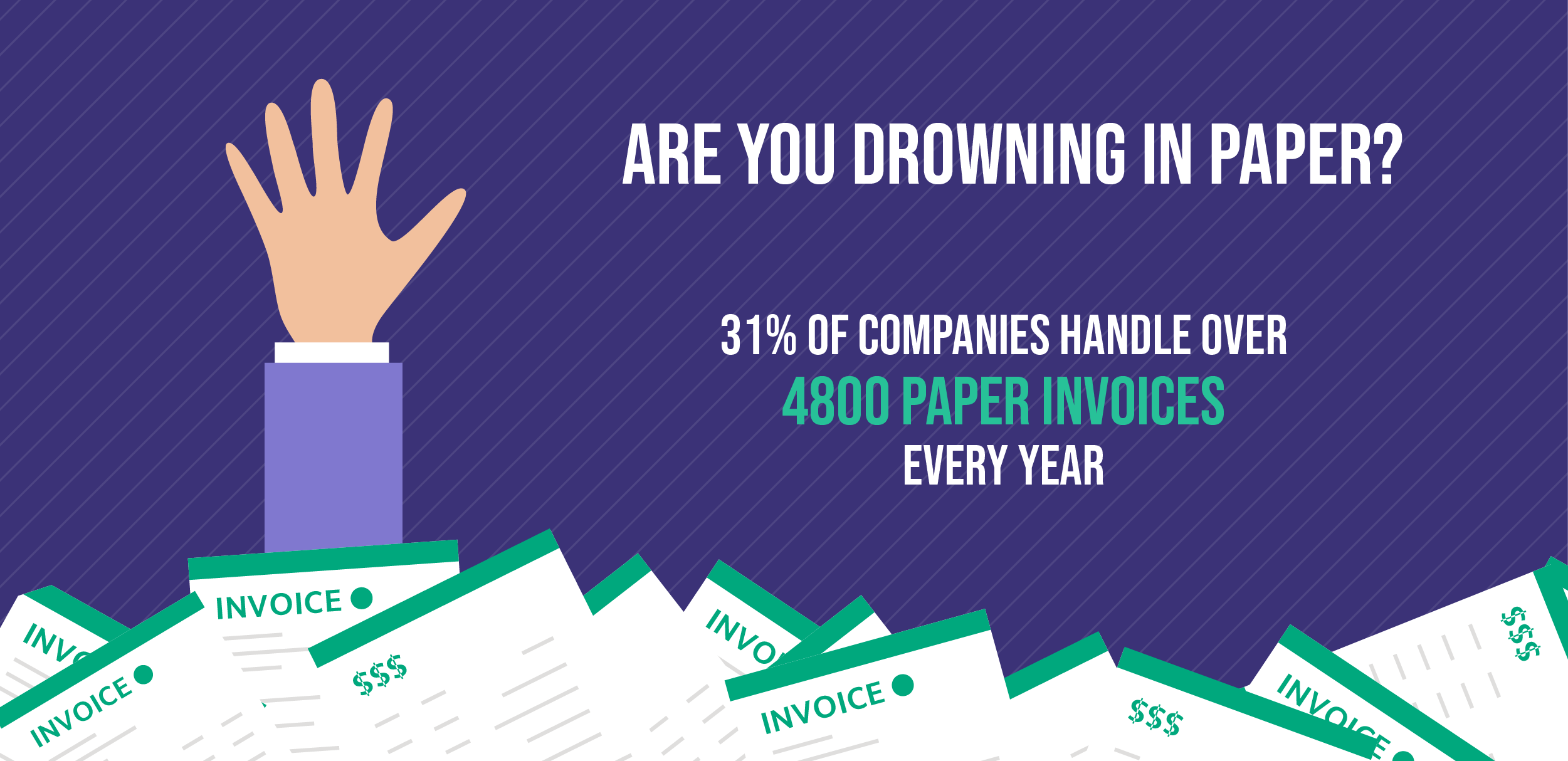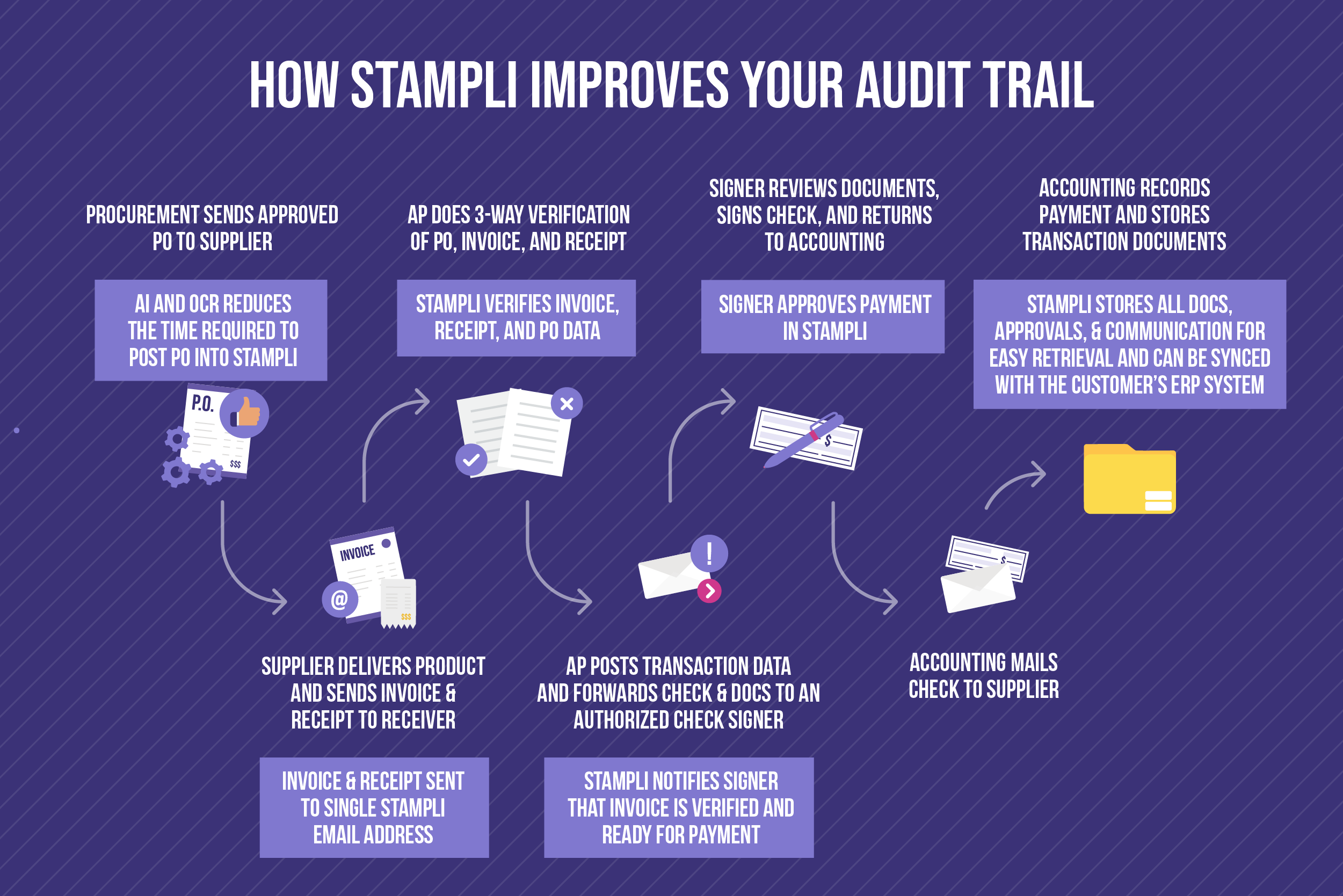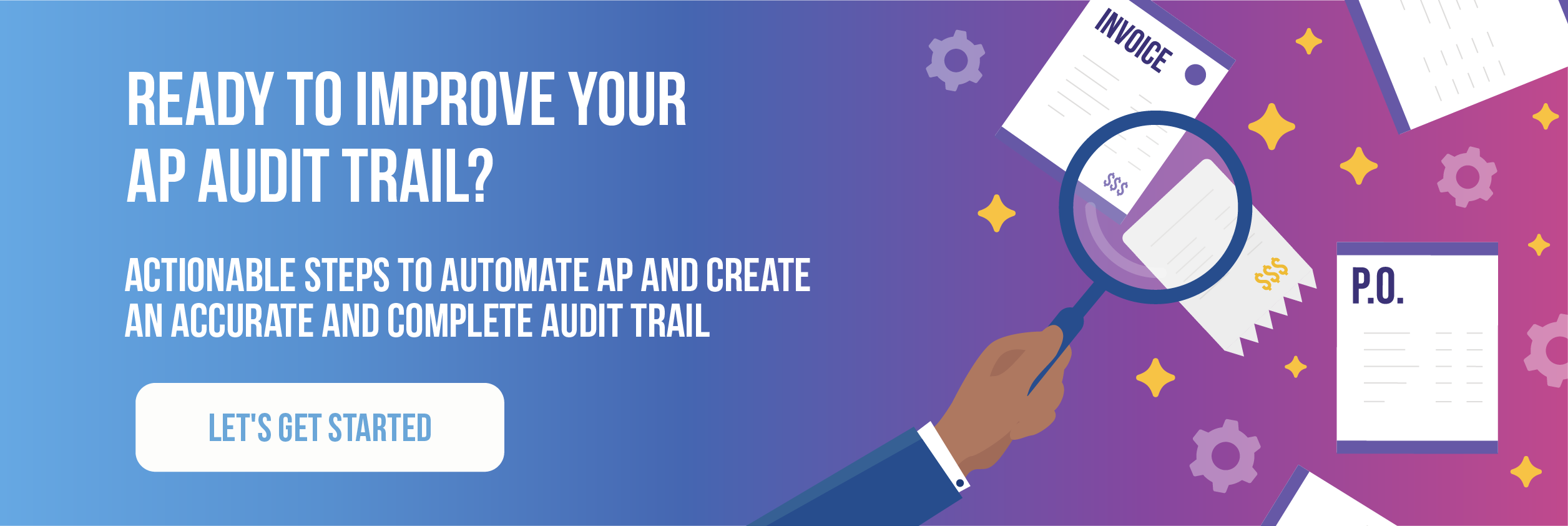The Ultimate Guide to Building a Good AP Audit Trail

The accounts payable audit trail is the detailed chronological record of all the transactions in your AP process. The AP audit trail contains the key details that auditors use to verify the transactions, processes, changes, communications, and accounting procedures that contribute to your company’s financial records.
A lot of money goes through accounts payable, so it’s crucial to know how that money gets spent. The performance of your AP processes directly impacts profitability, operating costs, and cash flow. Maintaining a clean AP audit trail ensures all transactions and activities are accurately and fully recorded, and the financial statements reflect actual business operations. A clean audit trail helps auditors detect potential fraud and errors, assess and improve process efficiency, and stay compliant with regulatory requirements.
In this guide, we’ll look at the components of the AP audit trail and how you can improve the auditing standards in your company to make your next external or internal audit more efficient and effective.
Why is the Accounts Payable Audit Trail Important?

The AP audit trail is all the information and documentation needed to verify every event in the accounts payable workflow. The accounts payable audit trail includes every step from the invoice arriving at accounts payable to payment approval.
Auditors rely on the accounts payable audit trail to provide the information they need to perform a complete and successful AP audit. The audit trail includes the information auditors need to verify what transactions, communications, or actions occurred and what person or system initiated them. Each entry in the audit trail should include details about what happened, the time and date it happened, what person or command initiated the action, and any associated documentation.
The Four Accounts Payable Audit Procedures
Generally, an AP audit seeks to confirm that a company is presenting an accurate view of its financial reporting, internal controls, and compliance with applicable laws and practices.
An accounts payable audit is essential to ensure that standard operating procedures (SOPs) are in place and followed, detect and mitigate fraud and errors, identify areas for process improvement, and ensure AP documentation and data are accurately captured. Although each audit is different, the AP audit process typically seeks to achieve four tasks:
1. Verifying Completeness of Records
Checking the completeness of financial records is the main auditing objective. Auditors compare and verify that all payable records from the AP department match the company’s financial statements. The audit includes reviewing the end-of-year close process and performing cut-off tests to ensure items are posted in the accounting period when the expenses were incurred. It can also include identifying and investigating unusual transactions.
2. Validating Compliance
Auditing for compliance ensures that accounts payable transactions and events are compliant with generally accepted accounting principles (GAAP) and Sarbanes-Oxley regulations by tracking transactions from start to finish. Examiners will look at the AP audit trail to confirm the business used the right accounting procedures, stayed compliant with policies and regulations, and received the correct discounts.
3. Checking Validity of Transactions
Validity testing identifies possible fraud and errors and ensures the audit trail and financial statements are free from material misstatements. Auditors will verify the validity of AP transactions to confirm they are accurate and legitimate. Validity testing usually involves contacting suppliers to verify the transaction data is accurate and legitimate and identifying and investigating any exceptions.
4. Confirming Data Accuracy
The information in the audit trail needs to be accurate. Auditors will examine accounts payable processes to confirm that transactions and events are being properly recorded and disclosed. This can include examining the Standard Operating Procedures (SOPs) in detail and testing how closely employees are following them. Auditors will also clarify and verify unusual transactions and ensure all payment amounts are recorded accurately.
It goes without saying that an accurate and up-to-date audit trail makes it much easier for auditors to complete these tasks successfully. So how do you maintain a good AP audit trail?
How to Create & Maintain a Good AP Audit Trail
A good accounts payable audit trail is complete, accessible, accurate, and up-to-date and provides all the details about a specific transaction or activity in your AP processes. Although every company’s AP processes are different, here are some steps you can take to build and maintain an audit trail in your organization.
Collect, Organize, and Update AP Documents
Gather together AP documents, ensure they are up to date, and store them in a centralized location or record their location so they can be accessed and searched easily. Examples of documents include:
- Vendor invoices
- Purchase orders
- Vendor contracts
- Supplier/vendor master file and log
- Employee master file
- AP aging report
- Expense policies
As part of the same process, identify and document exceptions such as one-off vendor contracts, invoices associated with scope of work (SOWs) or without vendor contracts, or purchases approved without a PO.
Build and Document Standard Operating Procedures
If you already have SOPs for accounts payable, ensure they’re written down, up-to-date and accessible. At a minimum, your SOPs should cover the processes for:
- Capturing and organizing incoming invoices
- Approving invoices for payment
- Matching invoices to purchase orders and order receipts (3-way matching)
- Approving and making payments
Verify that the SOPs have been implemented and followed, and identify and correct any weak or absent internal controls.
Identify and Document Roles and Verify Separation of Duties
Identify and document which employees are responsible for entering invoices, approving purchases, approving or making payments, or updating records. Ensure your accounts payable team has a clear separation of duties for critical tasks to reduce the risk of fraud and errors.
Review Payment Process and Policies
Analyze what methods (wire transfer, ACH, credit cards, payment cards, checks) your company issues payments to vendors. Verify and document your payment policy and confirm a policy to ensure payables are being recorded in the right accounting period. Also, verify that there are controls to prevent payment fraud or shadow spend and ensure these controls have been documented.
Review Vendor Relationships
Review existing supplier relationships and identify and document any contracts, quotes, estimates, SOWs, invoices, and communications. Check your SOPs to ensure there’s a process to vet and approve new vendors, confirm which employee(s) are authorized to add new vendors and if you have a policy restricting purchases to approved vendors.
Maintaining a Clean AP Audit Trail
Once the audit trail is in place, you can do a few things to ensure it stays up-to-date and accurate.
- Compare expense budgets to actual expenses or expenses from the previous year. Investigate any exceptional variances you find.
- Randomly check POs, invoices, journal entries, and bank statements for discrepancies and to ensure payment information is correct, and payments have been made.
- Verify payments and outstanding balances with suppliers and compare them to the accounts payable ledger transactions.
- Conduct cut-off testing to ensure items are recorded in the correct period.
- Search for unrecorded liabilities, cash or duplicate payments, and other suspicious transactions to detect fraud and errors.
These steps will help you organize your accounts payable processes and documents and build and maintain an accurate and accessible audit trail. However, as you’ve probably already guessed, manually building and maintaining an audit trail can be time-consuming. And like any manual AP process, it can be risky as well.
The Risks of Manual AP Audit Trails
Relying on manual processes and paper records is inefficient and can leave your business vulnerable to fraud and errors.
In our 2021 survey, AP Today: Bottlenecks, Benchmarks, & Best Practices, 54% of companies reported that they process over 6,000 invoices every year. At the top end of the scale, 15% of companies said they process over 60,000 invoices each year.

The same survey revealed that 40% of companies still receive paper invoices from suppliers, and 73% still manage invoices via email and spreadsheets.
Throw in all the emails and phone calls to manage this volume of invoices, and It should be no surprise that AP audit trails can get complicated and messy. Here’s what can go wrong:
The Problem with Paper
Paper invoices, purchase orders, receipts, and expense reports are risky, especially if your business relies on manual keying to enter data. Manual keying is prone to errors that can be difficult to catch and correct – verification requires tracking down the actual paper copy of the document.
Paper is also difficult to store and organize, is easily lost or destroyed, and can be tedious to retrieve. Auditing paper records can be a long, laborious (and expensive) process as auditors need to physically access, review, and validate every document.
The Trouble with Manual Approvals
Manual approvals of invoices or payments can be troublesome. Even if a company has clearly-defined approval levels, approvals can still take place via email, text, or phone. Finding and verifying these approvals during an audit can mean searching through thousands of emails – and good luck tracking down an approval by text or phone call.
The Difficulty with Corporate Credit Cards
Purchases made on corporate credit cards can be difficult to trace. Employees can share cards, which makes it difficult to confirm who made the purchase. There’s also the problem of shadow spend, where employees bypass expense policies and make purchases without approval. Other issues like auto-renewing purchases, employees using cards for personal purchases, and duplicate payments can result in many complicated credit card transactions that need to be examined one line item at a time.
The Challenge of Remote or Hybrid Work
Maintaining a solid audit trail can be particularly challenging for remote or hybrid organizations, especially if they are still using paper invoices or manual AP processes. It can be difficult to manage and store paper documents and manage and track AP tasks, approvals, and communications when employees work remotely. Tracking all this information may require a lot of expensive fieldwork for external auditors.
Accounts payable automation is the best way to ensure you build and maintain an accurate and up-to-date AP audit file. Automation centralizes and organizes AP data, controls and streamlines approvals, monitors check and electronic payments and credit cards, and facilitates remote and hybrid work environments.
How AP Automation Improves Your AP Audit Trail
An automated accounts payable solution is the best way to build and maintain an accurate, complete, and up-to-date AP audit trail. Automation reduces human error, prevents fraud, centralizes and organizes AP data, and enforces internal controls.
Many automation platforms, such as Stampli, provide powerful analytics and reporting capabilities that give you real-time visibility into your AP metrics so you can check on the health of your audit trail anytime. Here are some of the ways AP automation can improve the quality of your audit trail:
Centralize and Organize Data and Documents for Easy Access
AP automation platforms can capture, digitize, and store invoices and other paper documents in the cloud, making them easily accessible and searchable. This capability reduces data entry errors, eliminates duplicate invoices, and makes it easier for auditors to access this information.
Pro Tip: Look for a platform that offers AI-enhanced invoice scanning, verification, and general ledger coding for an even higher level of error detection and correction.
Provide End-to-End AP Process Visibility
Automated platforms provide real-time visibility of every stage of the AP process and will alert you of any discrepancies or errors. Real-time visibility lets you check on the status of any invoice at anytime from anywhere. It also enables you to confirm with a glance if internal controls are working properly.
Pro Tip: Look for a platform with a visual dashboard that lets you instantly check the status of an invoice or payment or verify that the AP team is following SOPs and internal controls.
Control Fraud and Errors
With an automated platform, invoices, POs, and receipts are stored so you can automatically perform most three-way matching tasks. Automated data capture and verification, real-time reporting, and stringent access controls also help your business prevent, detect, and mitigate fraud and errors quickly.
Pro Tip: Take advantage of platforms with AI and machine learning technologies for a higher level of protection against fraud.
Enforce Internal Controls
AP platforms let you quickly set up and enforce internal controls such as separation of duties and purchase and approval limits to prevent fraud and errors and ensure your financial records are accurate and compliant.
Pro Tip: Ensure that you choose an AP automation platform that provides flexible and auditable internal controls capabilities to make it easier to stay compliant.
Streamline and Control Payments
Automated AP platforms can help you manage and track different payment methods, schedule, verify, and record payments, and control and track payment approvals. You can easily control and change approver IDs and approval limits from within the platform.
Pro Tip: Consider a platform that offers integrated payments management to get complete end-to-end control of your AP processes.
Gain Control of Credit Card Spend with PCards
Credit card statements can be an auditing nightmare. Platforms with integrated payment cards provide real-time reporting and control of purchases so you can take control of spending. PCards also let you set internal controls such as limiting card use to a single employee, restricting purchases by vendor or project, and setting spending limits.
Pro Tip: Choose a payment card solution that integrates with your AP platform, accounting software, and ERP to simplify transaction processing.
Optimize and Manage Vendor Relationships
AP platforms can improve vendor relationships by making payments more timely and accurate. This makes negotiating, receiving, and tracking early payment discounts easier and reduces payment disputes. Platforms can also uncover insights by analyzing vendor spend by category, location, and other criteria.
Pro Tip: A platform with a vendor portal lets you centralize and record all vendor conversations so they can be easily accessed and searched by auditors.
Enjoy a Painless AP Audit with Stampli
Invest in creating and maintaining an accurate, up-to-date, complete, and compliant AP audit trail with Stampli. Stampli brings together all the elements of your audit trail: documentation, communications, payments, and activities, all in one place. By centering communications on the invoice itself, Stampli gives accounts payable departments total visibility and control of every transaction.

Audit-ready histories, financial data, and communications are stored in the Stampli system and can be accessed anytime from anywhere.
Stampli provides AI-enabled capabilities such as automated invoice entry, verification, and GL coding, an advanced search tool, and a vendor portal that gives you unprecedented control over your AP processes. Real-time dashboards and analytics let you examine, confirm, and test internal controls and confirm SOPs are in place and your AP team is following them.
Get a free demo of Stampli and make your next AP audit a painless experience.


